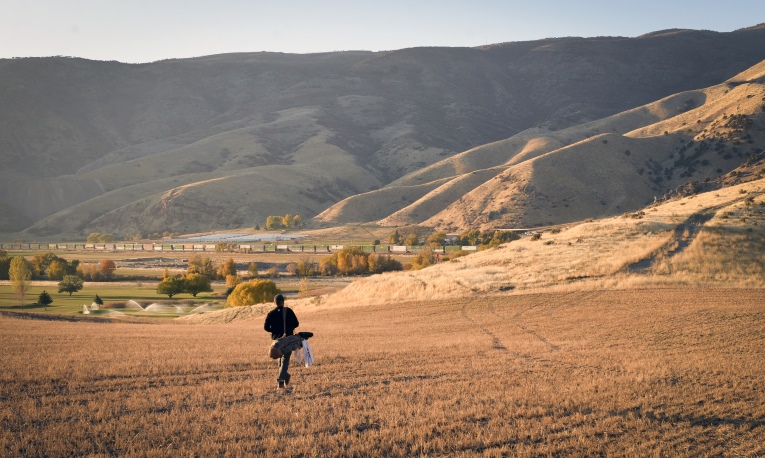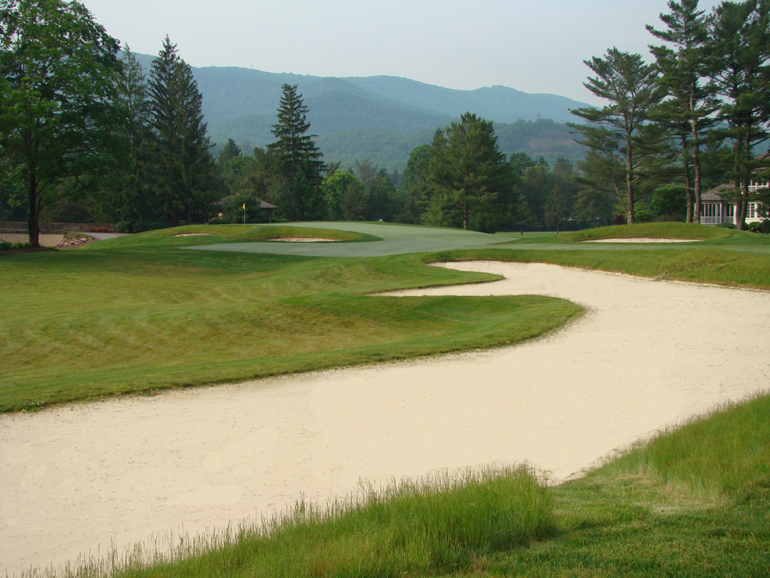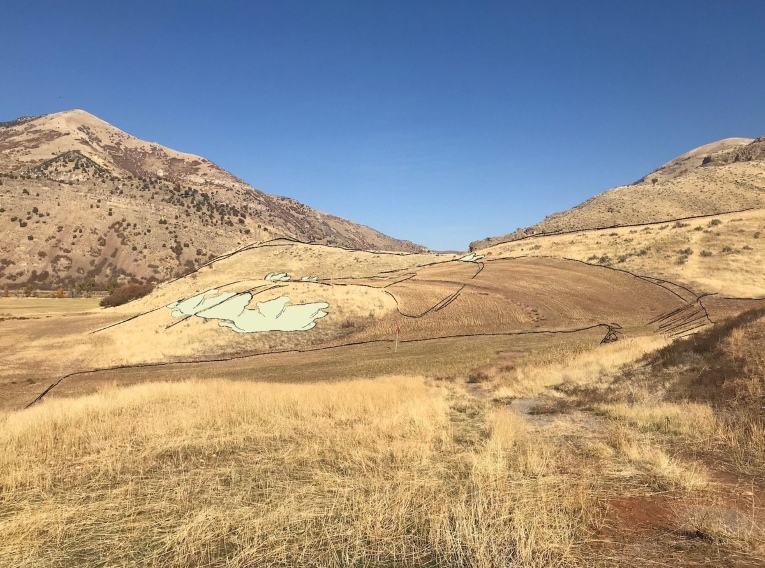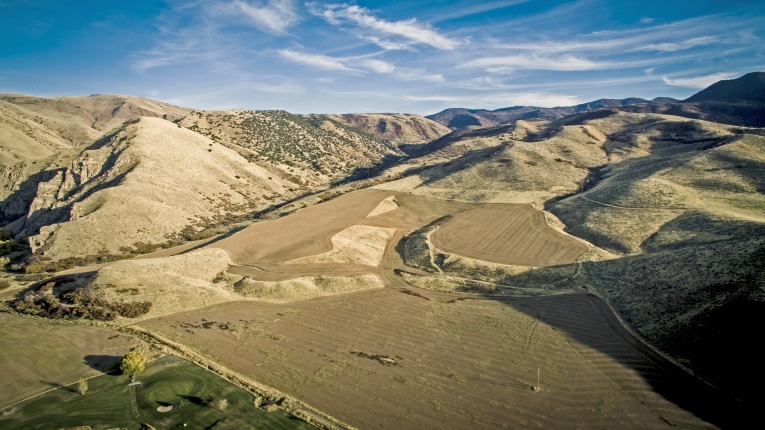Feature Interview
with
Zac Blair
January, 2018

Zac Blair playing dirt golf. Above, he is approaching what he intends to be the 105 yard Postage Stamp hole at The Buck Club in Utah.
Tell us a little about your golfing background. What courses did you grow up playing?
My dad is a professional golfer, so I was around golf a lot from a very young age. He would take me to tournaments around the country so that is where/when I started to love golf.
Our family owned a couple executive courses around Utah called Mulligans Golf & Games. I spent quite a bit of time hanging around with other golfers growing up. Mulligans was a nine hole course (one par 5, two par 4s, and six par 3s) with a 14,000 square feet putting and chipping green, and a massive driving range that could be lit up at night.
Having Mulligans growing up was the coolest thing you could have as a kid. We would spend all day at the course playing and all night practicing under the lights.
You are certainly an accomplished player. How and when did you become interested in golf architecture?
When I was growing up, my dad consulted and helped design several courses around Utah. It exposed me to this side of the golf business at a young age. When I was in 4th or 5th grade, my dad built a private 3 hole course next to Mulligans. It was my first opportunity to give my input on what I thought would be cool golf holes. Then when I was in junior high, my dad wanted to totally re-do all nine holes at Mulligans. You could call that re-do my first co-design, which is rare for a teenager. ☺ My dad gave me the opportunity to help with all the holes and green complexes. Looking back, a lot of my ideas were incorporated and it turned out to be one of the cooler nine hole golf courses I’ve ever seen. It’s safe to say that at a young age I was definitely a bit more in a “penal” design phase of my career.
Playing on the PGA Tour has exposed me to some great courses, but I really got into GCA when I played the Greenbrier Classic at TPC Old White my rookie year. It was my first look at CB Macdonald and Seth Raynor and I had never seen anything like it. It was love at first sight and I’ve been hooked ever since.
Do you think it is harder or easier for an ace player to appreciate good architecture?
It’s a case by case basis and that it’s something you have to learn to appreciate. Then you have to study it and see some of the great courses to experience it first hand. This way you learn what “great” is and you can quickly start to see and feel good or bad architecture when you are playing. An appreciation for good architecture and a low handicap are not necessarily related. Also, some good players are put off by quirk, which is sometimes an incredible piece of a design.
Can the nuances of a design be overwhelmed by drives that carry 300 yards and wedges that travel 150 yards?
Yes and no. More goes into this than players being able to hit the ball far. So much of today’s game is played through the air. I think the primary reason is the country’s fascination with courses being green, which usually results in soft playing conditions. The course conditions factor into the effectiveness of the course’s subtle nuances and contours. If you play a truly great design like The Old Course, NGLA, Chicago Golf Club, or Pine Valley with firm and fast conditions, the ground game becomes a relevant option. Instantly, the course regains those nuances which are a huge factor to what makes golf so fun.
How long does a course need to be to hold your interest? More than 6,500 yards? 6,750 yards? 7,000 yards?
I don’t think you can put a specific yardage on it. For instance, one of my favorite courses in the world is North Berwick, which measures just over 6,100 yards from the visitor’s tees. It’s one of the most entertaining courses I’ve ever played. I think holding interest comes down to having the proper design aspects that allow you to think your way around a golf course. Personally speaking, width and options are key factors to sustaining my interest.

With greens like its infamous 16th, North Berwick doesn’t need to measure 7,000 yards to provide an ample test.
Which courses on tour do you admire most? Why? How about just favorite courses in general?
I’d have to say Riviera. It does everything I talked about to hold your interest. Every hole has options and alternative routes of play. The greens are big enough and it has enough width to play strategically. Different hole locations require different positioning in the fairways to set up angles and score and the course typically plays firm and fast.
Pine Valley and National Golf Links of America are two world favorites. Both are extremely unique, offer different challenges and have that massive “WOW” scale throughout the entire round. I would say that Pine Valley is probably the best collection of 18 holes and NGLA is the most enjoyable 18 holes in the world.
Some of my favorites that are a little more under the radar include Somerset Hills in New Jersey and Kahuku golf course on the north shore of Honolulu. Somerset is one of the most enjoyable courses I’ve ever played, it is just a lot of fun. And Kahuku is a 9 hole municipal right on the beach and is as pure as golf gets. It’s not kept in “championship” conditions, it probably gets mown once a week and they rarely change the hole locations. However, it is on sandy soil, plays with a great ocean breeze and has some very cool holes that you can play over and over again without getting bored.
Which are your favorite Raynor template holes?
Redan, Biarritz, and Alps/Punchbowl with the caveat being they have to play firm and fast. These holes have nuances about them that become obsolete if they are slow and soft. Some of my favorites are the 7th at Chicago Golf Club (redan), the 9th at Piping Rock (biarritz), and the 4th at Fishers Island (alps/punchbowl).
Is shaping shots right to left or left to right a dying art form with technology? Or do some courses still make you move the ball both ways?
Advancements of technology have made it harder to hit those dramatic fades and draws, which has also made players more comfortable hitting straighter shots. Therefore, I think you could say “shaping shots” is kind of a dying art form. There are still guys like Bubba Watson that can really shape it both ways, but you definitely don’t see it as much.
Two courses that come to mind when thinking about shaping shots are Harbour Town and Colonial. Conditions also play a role in shot shaping, if it’s soft and you are able to just hit a high straight ball to a back left pin over a bunker, guys are comfortable doing that. If it gets firm and fast and straight shots over the same bunker won’t stop, you see more guys trying to hit one right to left and scoot it back to tucked flags.
Does your mindset change if you are approaching a green ringed by rough or one that has tightly mown banks that feed away? Which is scarier?
The answer totally depends on the conditions. If the rough is long and thick and the greens are firm, the rough is more unpredictable. On the other hand, if the chipping areas around the green are low and tight, this gives you options which can sometimes cause decision problems, thinking whether you should putt or chip or flip it. Both come with their own challenges and definitely play a role in how I decide to attack certain pins.
After playing in Australia earlier this year and seeing how amazing those courses are with virtually no rough around any greens, I concluded that I prefer this style for day to day golf. Options make golf fun and challenging at the same time.
What are a few examples where an approach shot makes you nervous even though you have a short iron in your hand?
Two that spring to mind are holes 3 and 14 at Muirfield Village in Ohio. You are usually hitting anywhere from sand wedge to 9 iron into those greens, but the way they are situated, they are very nerve wracking shots. If you play safe and miss left in the rough or bunkers, you are faced with extremely difficult chips. And if you miss right, you’re in the water and might have to hit the shot again.
Another example will be found at The Buck Club with our leven, hole #12. If you don’t hit a precise tee shot to give yourself the best angle possible or give yourself a good yardage, you are faced with a very intimidating approach with a wedge in your hand. The green is elevated and you are basically staring at a wall of bunkers, and the green is a fish hook, the front right is very shallow and the back left is very narrow. This forces you to either play safe (which is sometimes hard with a wedge in your hand) or get aggressive and if you miss you could have a very difficult up and down.

From the middle of the fairway, the green sits on top of a bluff with bunkers cut into the face of the hill.
Speaking of which (!), tell us more about your project in Utah – The Buck Club. How did you name it?
A dream of mine has been to build a world class golf club in my home state of Utah. We have several nice golf courses, but nothing that is close to world class. We also don’t have a truly great golf club that’s all about golf. That is where the name came from, The Buck Club, I wanted to “buck the trend” and go against the grain and bring something different to Utah. The Buck Club will be a place where golf purists can come and feel at home.
Could any template holes sneak into the design?
As far as templates are concerned, I would like to use them when they fit appropriately with the ideal routing. My goal was to take the great golden age design philosophies and combine them with more modern yardages and firm and fast conditions. The holes will play how they were intended to play back when Macdonald and Co. started to incorporate them into their designs.
Describe the raw property – what kind of soil, topography, how large is it?
The scale of the property is amazing. It has big and bold natural features that have been great to incorporate into the holes and the routing. One thing that makes some of the great courses great is the ability to keep the same scale for 18 holes. This is possible on this property, there is truly a “wow” factor when you’re walking around.

This portion of the property is referred to as the Upper 100 and holes 13-18 hole will be located here. From the upper left corner of this picture you can see 16-18 holes.
I guess it is safe to say you will strive to present fast and firms conditions based on several prior answers. How wide will the fairways be? Will there be central bunkers (i.e. bunkers completely encased in fairway grass)?
Firm and fast conditions are important to me. The Buck Club will strive to present these conditions day in and day out. Width, scale and variety will be a prevalent theme at The Buck Club. In our latest routings and course plans, most holes are wall to wall fairway and are roughly 50-70 yards wide. In Scotland’s Gift, when laying out the Ideal Course, C.B. Macdonald suggested width of fair green of the course to range from 45 to 60 yards. Given the advancement of technology, today’s ideal width falls between 50 and 70 yards. The width should give players ample room to play the holes strategically based on the hole’s pin position. Another theme you will see at the Buck Club are center line bunkers. They are something the golden age architects frequently used and I believe they represent one of the best design features to promote strategic design.
Where do things currently stand? Have you started taking outside investments?
In terms of the golf, a couple friends and I played dirt golf across holes 13-18 earlier this fall. We set cups and pins in the dirt, walked the course and had a great time. It’s rare to find a property that you can actually go play “dirt golf” and it speaks well of the natural properties of the land that we could have so much fun.
In terms of the club, we are currently in the process of wrapping up a business plan and we are looking for early investors to get involved.
I understand you are going to be hands-on throughout the process but will you have an architect to assist with the routing, drainage, etc?
I will be very hands on with The Buck Club. It is my brainchild, that I’ve been modifying for the past several years trying to make it the perfect course/club for people who really love golf. Dozens of people have helped along the way, so it has been a unique journey. Two people who caught my attention throughout the process, Tad King & Rob Collins, are who I’ve decided to bring on board to help with course construction. Obviously they are way more qualified than I could dream to be, and they have been extremely open to my ideas of what I want incorporated in this design. Their attention to detail and creative touch has been an amazing addition to The Buck Club.
Great news and smart move on your part. Finally, what do you hope to accomplish and how will you measure its success?
The idea of The Buck Club has always been to build an amazing club that is all about golf. It is something that Utah is missing, which is a shame as there are so many people here that truly love golf. At the end of the day, if I can build a club for golfers where they can come visit and have a great time, it will be a success.












